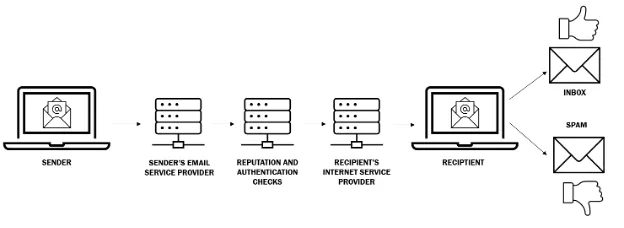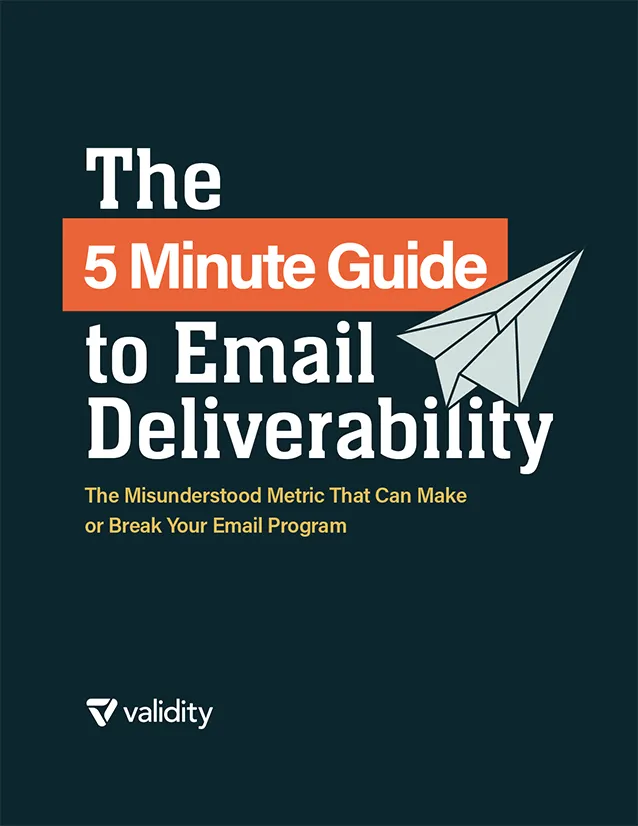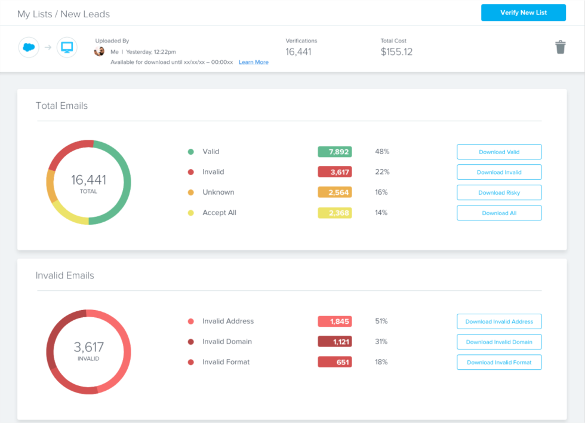It’s important to craft witty email copy, develop engaging subject lines, and send your email campaign at the right time—but your emails first have to land in your subscribers’ inboxes for these components to truly matter. While brainstorming flashy campaigns helps encourage engagement, email marketers also need to give attention to the environment they use to create email campaigns to guarantee their success and achieve solid email deliverability. Email deliverability is measured by inbox placement rate, or IPR.
What is email deliverability?
Email deliverability refers to the number of emails you send that actually land in your subscribers’ inboxes—instead of being blocked or marked as spam. The better your email deliverability, the more of your emails reach their intended recipients. Emails that bounce or get sent to spam by recipients or mailbox providers (MBPs) negatively affect your email deliverability.
The difference between email delivery and email deliverability
Email deliverability represents the ability of your emails to reach their intended recipients’ inboxes. Email delivery refers to the number of emails that were accepted by your subscribers’ MBPs.
“Delivered” means just that: The emails have been delivered, but they might have landed in the spam folder. “Deliverability,” however, tells you how many of your emails land where you want them to land: in the inbox.
Discover how Everest provides visibility into your inbox placement rate so you can accurately measure email performance and resolve issues preventing you from reaching your subscribers.
The importance of email deliverability
While email deliverability may not be a commonly tracked metric like email click-through rate or email unsubscribes, it’s a crucial factor of every successful email marketing program and should be included in your campaign reporting. Measuring deliverability allows marketers to gauge the health of their email lists and sender reputation, as well as whether or not their campaigns are reaching the intended audience.
Your email marketing program may appear successful if 97 percent of the emails you sent were delivered, but if half of these emails didn’t pass spam filters, your campaigns might not have been as effective at connecting with the audience you wanted to reach. While email delivery metrics are important, knowing your email deliverability rate will better reveal what improvements you need to make to reach more of your audience.
What is a good email deliverability rate?
A good email deliverability rate should be at least 85 percent—the higher, the better. A rate of 98 to 99 percent is ideal. Any deliverability rate below 70 percent is a sign that an email marketing campaign needs some improvement to show MBPs and recipients that the emails have value to offer.
How to check email deliverability
Several email deliverability testing tools can help you get an idea of where your inbox placement rate is right now and what you can do to improve it. Sender Score is just one popular option.
You can also sign up to Google Postmaster, Yahoo Feedback, and Microsoft SNDS to get insight into your sender reputation with these specific ISPs.
And then there’s Everest, the email success platform from Validity.
Everest provides extensive email deliverability tracking to ensure senders make it to subscribers’ inboxes. With comprehensive insights into your inbox placement rates, you can accurately measure email performance, fix issues, and keep your emails out of spam folders.
Everest empowers senders to:
- Monitor recipient inboxes to stay informed of how many emails reach the inbox.
- Take a proactive stance in improving sender reputation and sending infrastructure.
- Check email lists for problematic email addresses and improve list hygiene.
Some background: how email works
Before we dive into how you can improve your email deliverability, let’s review the basics of how email works. As senders, all we need to do is click a button, but behind the scenes, there is much more required to get an email from one person or company to another.
1. The email goes to the SMTP server
Whenever a sender creates an email and hits “send,” that email is transferred from server to server via the Simple Transfer Mail Protocol (SMTP) until it reaches its destination. To know what that destination is, the SMTP contacts the Domain Name System (DNS) server and checks whether that domain has any mail exchange servers with information about where the message should be sent.
A DNS is like a phone book. Just like a phone book connects a person’s name to a phone number so that you know where to call, a DNS links domain names (hostnames) to specific IP addresses so emails know where to go. Each link between a domain name and an IP address forms a DNS record. Each DNS record holds extra information that helps mailbox providers verify that a sender is authorized to send and receive email and that they’re using a legitimate emailing program.
2. The email is checked and verified
Once the SMTP has confirmed the email’s intended destination, it transfers the message to the email recipient’s Mail Transfer Agent (MTA) server, commonly hosted by an internet service provider (ISP, also known as a mailbox provider or email client) such as Gmail, Microsoft, or Yahoo. Before the email reaches the ISP’s server, additional checks are run on the sender’s authentication, IP and domain reputation, and infrastructure to ensure they are safe and can be trusted.
Each MBP has its own internal “rules” to determine which emails make it to the inbox versus the spam folder. So, your Gmail deliverability may look different from your Microsoft deliverability, for example.
3. The email is delivered
Once the email has successfully made it through the ISP’s gateway, it is considered delivered. The sender’s reputation and subscriber engagement history will determine if the mail will make it through spam filters and land in the inbox—or fail to pass the filters and end up in the spam folder.

Inbox placement rate is determined by the health of an email program. This health relies on adherence to email best practices in areas like list hygiene and subscriber engagement, but infrastructure and authentication also play a significant role in an email program’s success.
One in every six emails doesn’t reach the inbox.
Why you need solid email infrastructure
Your email infrastructure—the hardware and software used to send emails, including your IP address and DNS—is critical to verifying your identity and trustworthy reputation. A solid email infrastructure ensures your emails remain secure, showing MBPs that your domain is reliable and safe.
MBPs use email authentication protocols to confirm that an email comes from whom it claims to come from. These protocols also serve to protect recipients against spam, hacking, and phishing attempts. Authentication needs to be set up correctly for your emails to land in your recipients’ inboxes. These authentication protocols include:
Sender Policy Framework (SPF)
SPF checks follow an email’s path from origin to destination to help identify which IP addresses have the authority to send emails for a certain domain. MBPs and filtering systems can use the SPF record to tell forged emails apart from legitimate ones.
DomainKeys Identified Mail (DKIM)
DKIM adds a digital signature secured with encryption to every email sent. MBPs and receiving servers can use DKIM to validate senders and increase recipient protection against spoofing and phishing.
Domain-based Message Authentication, Reporting and Conformance (DMARC)
DMARC is a framework that sits atop SPF and DKIM authentication protocols to address exact domain spoofing and phishing attacks, stopping cybercriminals from pretending to email from your brand’s domain. It helps prevent unauthorized domain use in the “From” address of email messages by allowing senders to specify how MBPs should treat unauthenticated or non-compliant messages through three available policies:
- Policy is ‘none’ (p=none): MBPs will take no action and deliver the mail as normal
- Policy is ‘quarantine’ (p=quarantine): MBPs will send the message to spam/junk
- Policy is ‘reject’ (p=reject): MBPs will drop the message, and it will not be delivered to recipients
Learn more about email deliverability, what affects your deliverability, and how your deliverability impacts your email performance.
A note on IP addresses
You can have a shared or dedicated IP address. As the name suggests, shared IP addresses are used or shared by different senders, while dedicated IP addresses are used by only one sender.
Since internet service providers use your IP address to evaluate your sender reputation, using a dedicated IP address can be a way to put you in full control. However, you should always take into account your send volume, mailing frequency, email marketing expertise, and email marketing budget before deciding which type of IP address to go with.
A few pointers when deciding which IP address type is best for your organization:
- Dedicated IP addresses are more expensive than shared ones.
- Dedicated IP addresses only work well for brands that frequently send large volumes of emails, as that’s needed to establish a solid send history and reputation.
- Dedicated IP addresses need to be warmed up since sending large volumes of emails from a new IP address can trigger spam filters.
- You need to manage and maintain a dedicated IP.
- Shared IPs are more forgiving, as any mistakes you make with your email marketing are balanced out by the best practices employed by all the other senders using the same IP.
- But the opposite is also true: On a shared IP, the negative actions of other senders can impact your reputation.
Key components to managing your sender reputation
Email clients use sender reputation to determine whether an email is likely to be trustworthy or not. Your sender reputation can mean the difference between landing in the inbox, getting sent to spam, or—even worse—being blocked completely.
A poor sender reputation means fewer emails are delivered to subscribers’ inboxes, and fewer subscribers get your emails—meaning fewer subscribers can convert.
Ultimately, a bad sender reputation hurts your ROI.
Major factors of sender reputation include email engagement and list hygiene.
List engagement
List engagement refers to how subscribers interact with your emails.
There are two types of engagement:
- Positive engagement: You can track positive engagement through signals such as subscribers rescuing an email from the spam folder or marking it as “not junk,” opening the email, clicking on a link within the email, forwarding the email or replying to it.
- Negative engagement: Watch for negative engagement signals, including actions like deleting the email without opening it or marking the email as spam or junk, as getting spam complaints is the number one thing that hurts your sender reputation.
List hygiene
List hygiene refers to how clean and up-to-date an email list is. To maintain healthy list hygiene, email marketers need to regularly check their lists for incorrect email addresses and unengaged subscribers.
There are three types of email addresses you’ll want to eliminate from your lists:
- Unknown users: Unknown users are invalid or unrecognized email addresses in a sender’s database. They include email addresses that have been abandoned and shut down by the email client, as well as incorrect email addresses that contain typos. Sending to these types of email addresses will lead to higher bounce rates.
- Recycled spam traps: Recycled spam traps, sometimes called repurposed spam traps, are email addresses that used to be active email addresses but are now used by MBPs to catch spam and other types of unwanted email. A user could have used the email to opt-in at one time but has since abandoned the address. Recycled spam traps are more common on sending lists that are old and used infrequently.
- Pristine spam traps: Pristine spam traps, also referred to as true traps or honeypots, are email addresses created solely to capture spammers. These email addresses were never legitimate email addresses. They can’t be used to create accounts, sign up for lists, or make purchases, so they can catch senders with poor list-building practices.
Sending to these types of email addresses negatively impacts your sender reputation and the chances of an email making it past the receiving mail server’s gateway and into the inbox.
For best results, you should implement a list validation solution that identifies incorrect or invalid emails at the point of capture and prevents them from being added to your list. You should also choose to grow your email list organically rather than buying or renting it, as there is no guarantee the names on a purchased list consented to be added to the list, or even belong to real people.
Purchasing an email list is a bad idea for several reasons, including:
- You’ll violate privacy laws like GDPR—and run the risk of hefty fines.
- The people on these lists don’t know you and are thus more likely to mark your emails as spam.
- You don’t have control over the quality of these email addresses.
Companies that have poor email acquisition practices can end up repeatedly mailing their email campaigns to spam traps—and quickly land on blocklists. Keeping your email list clean and as accurate as possible helps you prove your trustworthiness to MBPs and recipients, enabling you to land in more inboxes and reach more people.
Discover how BriteVerify, from Validity, can help keep your email lists clean to protect your sender reputation.
Best practices to improve email deliverability
In addition to a solid sender reputation and a correctly configured infrastructure and authentication record, following general email best practices will help boost email deliverability. Email delivery best practices should be followed by all marketers since they help maintain a strong sender reputation. This is something MBPs consider when determining whether to let the email get past the gateway and whether the message should land in the inbox or spam folder.
Perform volume management
It’s common for malicious senders to use an IP address with no existing send history or reputation to send as many emails as possible within a short time frame—before MBP filters can catch them and block them. As a result, MBPs favor senders that have an established history of consistent sending. If you’re sending from a new domain, slowly build volume and frequency over time so you don’t trigger spam filters. This concept is known as IP warming.
It can also be a good idea to spread campaigns to large numbers of subscribers over a few days so there are no volume spikes, but this mainly applies when you’re a new sender or don’t have a history of sending to a lot of people at once. Most likely, you’ll want to increase your send frequency at certain times of the year, such as during the Black Friday weekend and holidays. In these cases, it’s good to slowly increase your send frequency in the run-up to these events.
Be aware of how many emails your subscribers expect or want to receive. Sending too many emails in a short time frame can potentially annoy subscribers and lead to unsubscribes that hurt your sender reputation.
Segment and personalize
Segmenting your list based on your audience’s demographics and behavior is an email marketing best practice, as is personalizing your emails to suit their preferences. Writing customized content with personal appeal through practices such as including subscribers’ first names is also helpful for connecting with your audience.
Following these personalization best practices positively affects your email deliverability as subscribers will be more likely to stay engaged with content that tailors to their specific needs. Better engagement means fewer unsubscribes, fewer spam complaints, and higher chances of conversion. These are all things that improve your email marketing deliverability, as well.
Create a suppression list
Most brands have inactive subscribers on their lists. These people don’t officially opt out, but they also don’t read or otherwise engage with the brand’s emails in any way. If you have inactive subscribers, it’s a good idea to group them together so you can avoid sending them anything else, apart from a possible re-engagement campaign.
Why?
If they keep receiving but not engaging with your emails, that’s a bad sign to MBPs, and it can negatively impact your email deliverability. Low engagement rates can cause MBPs to think that your content is potentially spammy or unwanted, leading to a lower sender reputation. As you send fewer emails to inactive subscribers, you can focus more on those who do engage with your content and improve your email deliverability.
When you should add someone to your suppression list depends largely on your email frequency. If you email your list three times a week, you might consider someone inactive if they haven’t engaged with your emails for more than a month. If you only email your subscribers twice a month, you’ll want to wait longer before you consider someone inactive.
Have a compliant opt-in process
We already mentioned above how important it is to avoid buying or renting email lists because, among other reasons, the people on those lists haven’t chosen to be contacted by you.
The same goes for anyone else you add to your list without having explicit confirmation that they actually want to be there. Yes, that means implementing a double opt-in process. While having a single opt-in is still legal in the United States (not so much in Europe—check the GDPR rules), it’s not an email best practice.
Someone who gives you their email address to receive order confirmations might not want to receive your promotional emails, for example. By having people confirm they want to be on your email list, you increase your chances of getting high engagement, and you decrease your risk of unsubscribes and spam complaints.
Pro tip: Ask new subscribers to add you to their email address book. That’s a surefire way to stay out of the spam folder.
Offer easy opt-out methods
Email best practices require senders to make it easy for subscribers to opt out of their programs. That means having an easy-to-spot unsubscribe link in all of your emails.
It’s even better if you offer a one-click unsubscribe process. Someone who already decided they don’t want to hear from you anymore doesn’t want to go to a new tab to confirm their unsubscription when they’ve just clicked “unsubscribe.” Generally speaking, it’s annoying and won’t leave a good impression. What you do want to do is provide confirmation that they’ve successfully unsubscribed.
If you’re running more than one email campaign, include a link for people to update their email preferences. That way, they can choose to opt out of some of your communications while still receiving others.
Build brand recognition
A less technical factor that impacts your email deliverability is your brand recognition. The more your subscribers know and love your brand, the more likely they are to open your emails. And a high open rate is a positive signal for mailbox providers to trust your brand and send its emails straight to the inbox.
To ensure your email marketing program benefits from positive brand recognition, consider these best practices:
- Keep your branding consistent across all channels: While it may be tempting to try flashy techniques with your email templates, it’s more important that subscribers can clearly spot an email as coming from you, especially if they already trust you. Consistent branding also helps you build a relationship with your subscribers. If your branding extends to your subject lines, it makes you easy to spot in the inbox.
- Foster trust by making your identity clear: Include your brand name in your sender’s “from” address so there’s no hesitation about whom the email is from. You can try including a person’s name, as well, such as sending promotional emails from “Jennifer at Validity” versus “Validity.” Oftentimes, these personalized sender names perform better.
- Send emails from your own domain: The domain you’re sending from plays a key role in successful branding. You should always send from your company’s domain. Sending from a free email address provider such as Gmail looks spammy and comes across as highly unprofessional.
“We are clear there’s a straight-line relationship between better inbox placement performance and Philips’ program revenue. We also now have a deep understanding of what affects our deliverability and why, which has improved our engagement levels significantly.”
Avoid email subject line malpractices
Your subscribers aren’t the only ones reading your subject lines. Their email clients are, too, and most have strict filters in place to weed out spam. Those filters catch the exact same things recipients tend to find annoying, including:
- Subject lines in all caps
- Subject lines full of exclamation points
- Subject lines using spam trigger words such as “free,” “buy,” “earn,” “prize,” and “winner”
- Subject lines in strange fonts
A good rule of thumb is to make your subject lines descriptive and engaging without overdoing anything.
Be mindful of email body malpractices
A good email is an email that can be read in its entirety. If it can’t, you risk frustrating the recipient, and they might just unsubscribe—or worse, send you to spam.
To increase the chances of your emails being received in their full glory, follow these tips:
- Be careful when using fancy elements like forms, videos, or dynamic scripts such as JavaScript that are not displayed by all mailbox providers.
- Avoid including any attachments.
- Optimize images you embed so they don’t slow down the email’s load time.
- Use alt text for your images in case your subscribers’ email clients don’t automatically load images.
- Maintain a balanced text-to-HTML ratio to avoid looking spammy to the filters.
- Keep links to a minimum and ensure they are complete links since URL shorteners can set off spam filters.
Enhance email marketing success with effective email deliverability
Getting your emails into your subscribers’ inboxes is the very first step toward a successful email marketing program. For this reason, senders need to prioritize email deliverability by following reliable email best practices that improve their reputation, engagement, and authority.
Email deliverability is influenced by a range of elements, from technical components, such as your email infrastructure and the correct configuration of your authentication settings, to list hygiene and subscriber-facing components, such as brand recognition and email content. Monitoring your email deliverability and all the elements that affect it is crucial for uncovering vulnerabilities and ensuring your sender reputation remains strong.
Schedule a free demo to see how Validity can help you improve your sender reputation so you get more messages to more people.


